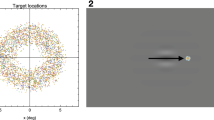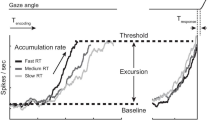Abstract
The ability to produce “express sacccades” is associated with adequate functioning of saccadic burst cells in the superior colliculus. Saccadic burst cells appear to be under the inhibitory control of both the collicular and the dorsolateral frontal fixation systems. Twenty schizophrenia patients and 20 nonpsychiatric subjects were presented a saccade task that included five different gap intervals (0, 100, 200, 300, and 400 ms) between fixation point offset and peripheral target onset (at ±4°). All subjects generated the highest frequency of express saccades in trials with a gap interval of 200 ms. Schizophrenia patients had an increased frequency of express saccades across gap intervals, especially for targets presented in the right visual field. The groups did not differ in the percentages of anticipatory saccades or saccadic amplitudes. These results suggest that schizophrenia patients' saccadic burst cells in the superior colliculus are functioning adequately, but may be consistent with dys-function of dorsolateral frontal cortex and/or its interconnecting subcortical circuitry.
Similar content being viewed by others
References
American Psychiatric Association (1987) Diagnostic and statistical manual of mental disorders (revised 3rd edn). APA, Washington, DC
Becker W (1989) Metrics. In: Wurtz RH, Boch RA (eds) The neurobiology of saccadic eye movements. Elsevier, Amsterdam, pp 13–67
Braun D, Weber H, Mergner TH, Schulte-Montig J (1992) Saccadic reaction times in patients with frontal and parietal lesions. Brain 115:1359–1386
Buchsbaum M (1990) The frontal lobes, basal ganglia, and temporal lobes as sites for schizophrenia. Schizophr Bull 16:379–389
Butler RN, Jenkins MA, Braff DL (1993) On the abnormality of comparison groups: the identification of psychosis-proneness and substance abuse in putatively normal research subjects. Am J Psychiatry 150:1386–1391
Claridge GS, Clark KH, Beech AR (1992) Lateralization of the ‘negative priming’ effect: relationships with schizotypy and with gender. Br J Psychol 83:13–23
Clark CR, Geffen GM, Geffen LB (1989) Catecholamines and the covert orientation of attention in humans. Neuropsychologia 27:131–139
Clementz BA (1996) Saccades to moving targets in schizophrenia: Evidence for normal posterior cortex functioning. Psychophysiology (in press)
Clementz BA, McDowell JE, Zisook S (1994) Saccadic system functioning among schizophrenia patients and their first-degree biological relatives. J Abnorm Psychol 103:277–287
Cummings JL (1993) Frontal-subcortical circuits and human behavior. Arch Neurol 50:873–880
Currie J, Joyce S, Maruff P, Ramsden B, McArther-Jackson C, Malone V (1993) Selective impairment of express saccade generation in patients with schizophrenia. Exp Brain Res 97:343–348
Cutting J (1990) The right cerebral hemisphere and psychiatric disorders. Oxford University Press, New York
Falkai P, Bogerts B, Greve B, Pfeiffer U, Machus B, Folsch-Reetz B, Majtenyi C, Ovary I (1992) Loss of sylvian fissure asymmetry in schizophrenia: a quantitative post mortem study. Schizophr Res 7:23–32
Fischer B, Boch R (1983) Saccadic eye movements after extremely short reaction times in the monkey. Brain Res 260:21–26
Fischer B, Boch R, Ramsperger E (1984) Express-saccades of the monkey: Effect of daily trianing on probability of occurrence and reaction time. Exp Brain Res 55:232–242
Fischer B, Ramsperger E (1984) Human express saccades: Extremely short reaction times of goal directed eye movements. Exp Brain Res 57:191–195
Fischer B, Ramsperger E (1986) Human express saccades: Effects of randomization and daily practice. Exp Brain Res 64:569–578
Fischer B, Weber H (1993) Express saccades and visual attention. Behav Brain Sci 16:553–610
Fischer B, Weber H, Biscaldi M, Aiple F, Otto P, Stuhr V (1993) Separate populations of visually-guided saccades in humans: reaction times and amplitudes. Exp Brain Res 92:528–541
Fukushima J, Fukushima K, Miyasaka K, Yamashita I (1994) Voluntary control of saccadic eye movements in patients with frontal cortical lesions and Parkinsonian patients in comparison with that in schizophrenics. Biol Psychiatry 36:21–30
Guitton D, Buchtel HA, Douglas RM (1985) Frontal lobe lesions in man cause difficulties in suppressing reflexive glances and in generating goal-directed saccades. Exp Brain Res 58:455–472
Hathaway SR, McKinley JC (1982) Minnesota Multiphasic Personality Inventory. University of Minnesota Press, Minneapolis
Johnson MH (1990) Cortical maturation and the development of visual attention in early infancy. J Cogn Neurosci 2:81–95
Kaplan HI, Sadock BJ, Grebb JA (1994) Synopsis of psychiatry, 7th edn. Williams & Wilkins, Baltimore, MD
Keithley Instruments (1992) ASYST: a scientific system (version 4.0) [Computer program]. Keithley Instruments, Tuanton. MA
Kennard C, Lueck CJ (1989) Oculomotor abnormalities in diseases of the basal ganglia. Rev Neurol 145:587–595
Larzelere RE, Mulaik SA (1977) Single-sample tests for many correlations. Psychol Bull 84:557–569
MacLean CJ, Morton NE, Elston RC, Yee S (1976) Skewness in commingling distributions. Biometrics 32:695–699
Matsue Y, Osakabe K, Saito H, Goto Y, Ueno T, Matsuoka H, Chiba H, Fuse Y, Sato M (1994a) Smooth pursuit eye movements and express saccades in schizophrenic patients. Schizophr Res 12:121–130
Matsue Y, Saito H, Osakabe K, Awata S, Ueno T, Matsuoka H, Chiba H, Fuse Y, Sato M (1994b) Smooth pursuit eye movements and voluntary control of saccades in the antisaccade task in schizophrenic patients. Jpn J Psychiatry 48:13–22
Mayfrank L, Mobashery M, Kimmig H, Fischer B (1986) The role of fixation and visual attention in the occurrence of express saccades in man. Eur Arch Psychiatry Neurol Sci 235:269–275
McDowell JE, Clementz BA (1996) Ocular motor delayed-response task performance among schizophrenia patients. Neuropsychobiology (in press)
McDowell JE, Clementz BA, Wixted JT (1996) Timing and amplitude of saccades during predictive saccadic tracking in schizophrenia. Psychophysiology 33:93–101
McGue M, Gerrard JW, Lebowitz MD, Rao DC (1989) Commingling in the distributions of immunoglobin levels. Hum Hered 39:196–201
Munoz DP, Wurtz RH (1992) Role of the rostral superior colliculus in active visual fixation and executation of express saccades. J Neurophysiol 67:1000–1002
Munoz DP, Wurtz RH (1993a) Fixation cells in monkey superior colliculus. I. Characteristics of cell discharge. J Neurophysiology 70:559–575
Munoz DP, Wurtz RH (1993b) Fixation cells in monkey superior colliculus. II. Reversible activation and deactivation. J Neurophysiol 70:559–589
Nozawa G, Reuter-Lorenz PA, Hughes HC (1994) Parallel and serial processes in the human oculomotor system: bimodal integration and express saccades. Biol Cybern 72:19–34
Petty RG, Barta PE, Pearlson GD, McGilchrist IK, Lewis RW, Tien AY, Pulver A, Vaughn DD, Casanova MF, Powers RE (1995) Reversal of asymmetry of the planum temporale in schizophrenia. Am J Psychiatry 152:715–721
Pierrot-Deseilligny C (1994) Saccade and smooth-pursuit impairment after cerebral cortical lesions. Eur Neurol 34:121–134
Pierrot-Deseilligny C, Rosa A, Masmoudi K, Rivaud S (1991) Saccade deficits after a unilateral lesion affecting the superior colliculus. J Neurol Neurosurg Psychiatry 54:1106–1109
Rascol O, Clanet M, Montastruc JL, Simonetta M, Soulier-Esteve MJ, Doyon B, Rascol A (1989) Abnormal ocular movements in Parkinson's disease. Brain 112:1193–1214
Rivaud S, Müri RM, Gaymard B, Vermersch AI, Pierrot-Deseilligny C (1994) Eye movement disorders after frontal eye field lesions in humans. Exp Brain Res 102:110–120
Saslow MG (1967) Latency for saccadic eye movement. J Opt Soc Am 57:1030–1033
Sawaguchi T, Goldman-Rakic PS (1994) The role of D1-dopamine receptors in working memory: local injections of dopamine antagonists into the prefrontal cortex of rhesus monkeys performing an oculomotor delayed-response task. J Neurophysiol 71:515–528
Schiller PH, Sandell JH, Maunsell JHR (1987) The effect of frontal eye field and superior colliculus lesions on saccadic latencies in the rhesus monkey. J Neurophysiol 57:1033–1049
Sereno AB, Holzman PS (1993) Express saccades and smooth pursuit eye movement function in schizophrenic, affective disorder, and normal subjects. J Cogn Neurosci 5:303–316
Spitzer RL, Williams JB, Gibbon M, First MB (1988) Structured clinical interview for DSM-III-R. Biometrics Research Department, New York State Psychiatric Institute, New York
Thaker GK, Nguyen JA, Tamminga CA (1989) Increased saccadic distractibility in tardive dyskinesia: functional evidence for subcortical GABA dysfunction. Biol Psychiatry 25:49–59
Weban-Smith MG, Findlay JM (1991) Express saccades: is there a separate population in humans? Exp Brain Res 87:218–222
Weber H, Latanov A, Fischer B (1993) Context-dependent amplitude modulations of express and regular saccades in man and monkey. Exp Brain Res 93:335–344
Weinberger DR, Aloia MS, Goldberg TE, Berman KF (1994) The frontal lobes and schizophrenia. J Neuropsychiatry Clin Neurosci 6:419–427
Author information
Authors and Affiliations
Rights and permissions
About this article
Cite this article
Clementz, B.A. The ability to produce express saccades as a function of gap interval among schizophrenia patients. Exp Brain Res 111, 121–130 (1996). https://doi.org/10.1007/BF00229561
Received:
Accepted:
Issue Date:
DOI: https://doi.org/10.1007/BF00229561




